A Beginner'S Resource On E-Bike Legalities And Laws In Your Neighborhood
A Beginner'S Resource On E-Bike Legalities And Laws In Your Neighborhood
Blog Article
visit the next post Written By-Lynch Stanton
Prior to you hop on your e-bike and hit the streets, it's important to comprehend the regulations and guidelines that regulate your city. From speed restrictions to assigned riding areas, there's a whole lot to think about to guarantee you're certified and safe. By familiarizing on your own with the policies particular to e-bikes, you'll be better furnished to enjoy your rides with no unanticipated lawful concerns. Keep tuned to find essential insights that will certainly assist you navigate the e-bike landscape in your city perfectly.
Recognizing E-Bike Category
When it involves browsing the realm of e-bike regulations and laws, a vital starting factor is understanding the classification system that classifies these electric bicycles. E-bikes are typically categorized into 3 major groups: Class 1, Course 2, and Course 3.
Class 1 e-bikes are pedal-assist just, indicating they give help while the rider is pedaling and have a maximum speed of 20 miles per hour. These bikes are admitted areas where traditional bikes are permitted.
Course 2 e-bikes are outfitted with a throttle that can drive the bike without pedaling. They also have a maximum speed of 20 mph and appropriate for cyclists that might need support without pedaling continually.
Class 3 e-bikes resemble Class 1 yet with a higher maximum speed of 28 mph. These bikes are often restricted from certain bike courses or tracks because of their higher rates.
Recognizing these classifications is essential for adhering to local laws and guaranteeing a risk-free and enjoyable e-biking experience.
Navigating Rate Restrictions and Restrictions
To effectively navigate e-bike legislations and laws, it's important to recognize the speed restrictions and constraints that put on various courses of electrical bikes.
Rate limitations for e-bikes differ depending upon the category of the bike. Class 1 e-bikes, which are pedal-assist just and have a maximum speed of 20 mph, are generally enabled on bike lanes and courses.
Class 2 e-bikes, which have a throttle in addition to pedal-assist and also get to speeds of as much as 20 miles per hour, might be limited in specific areas where motorized vehicles aren't permitted.
Course 3 e-bikes, with pedal-assist approximately 28 mph, are normally needed to comply with the exact same policies as conventional bikes.
It is necessary to stick to these rate limits and limitations to guarantee your safety and security and the security of others when traveling. Prior to riding your e-bike, acquaint yourself with the specific laws in your city to stay clear of any prospective fines or legal problems.
Where to Ride Your E-Bike
To figure out where you can ride your e-bike, it's vital to understand the guidelines and standards particular to your location. In most locations, e-bikes are usually permitted on roads and roads where traditional bicycles are permitted. This might include bike lanes, bike paths, and shared highways. Nevertheless, it's vital to inspect regional regulations as some cities may have specific limitations on where e-bikes can be ridden.
When riding https://fattireebikefactory12109.bligblogging.com/33649462/e-bike-classifications-explained-understanding-the-ramifications-of-each-classification -bike, always focus on safety by following website traffic regulations and appreciating pedestrian walkways. In addition, be mindful of any type of designated bike lanes or courses in your location and utilize them whenever feasible to ensure a smoother and more secure experience.
Some cities also have regulations concerning e-bike use on pathways, so ensure to acquaint on your own with these policies to prevent any penalties or penalties.
Conclusion
Now that you know with the legislations and guidelines surrounding e-bikes in your city, you can confidently hit the road knowing where you can ride and what limitations put on your e-bike classification. Remember to always prioritize safety and security and follow the rules to make certain a smooth and legal trip. Happy riding!
